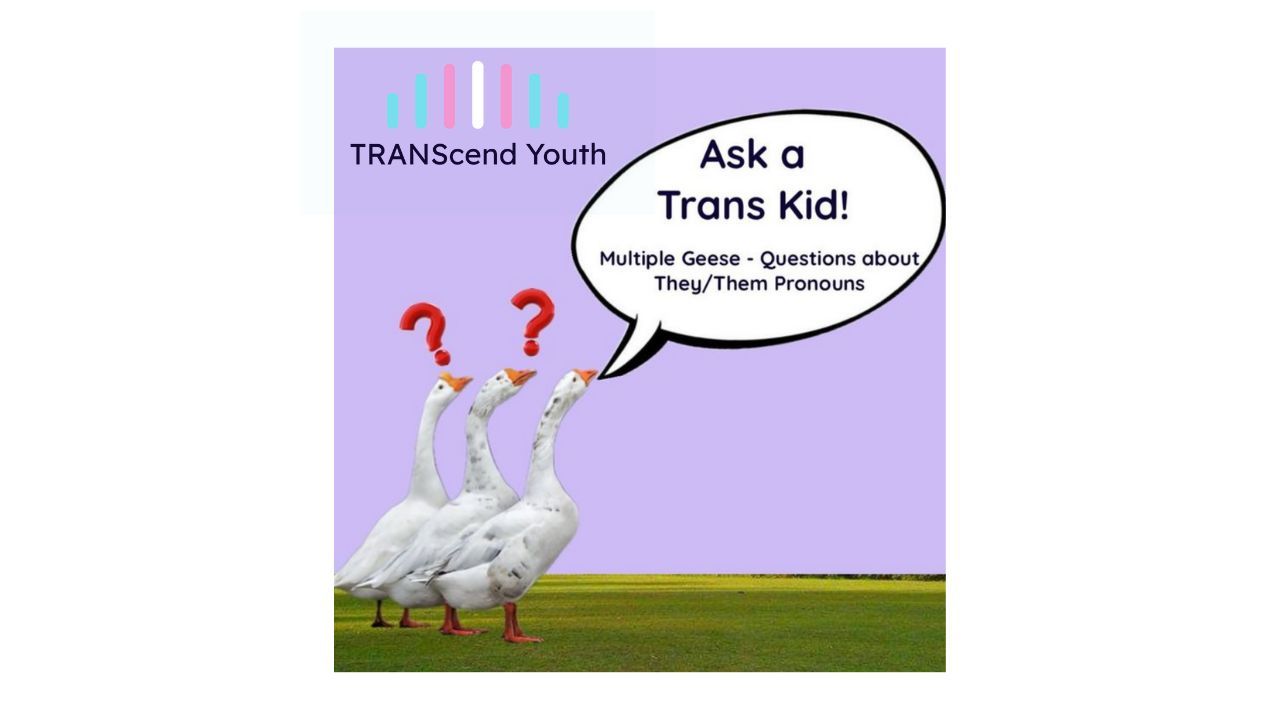
TRANScend Youth Feature: Ask a Trans Kid
Oct 12, 2023This post is from one of our wonderful community partners, TRANScend Youth. TRANScend Youth is a pending nonprofit focused on education, advocacy, and community building for transgender youth, by transgender youth. Through public speaking, community events, and online advocacy, TRANScend Youth hopes to build community and help create a better, kinder, and more educated world for young trans and gender diverse people.
TRANScend Youth's blog will host a variety of articles, essays, and artwork all created by trans and genderdivergent youth, and their "Ask A Trans Kid" series, featured below, lets folks ask questions to youth about the trans experience. You can learn more about TRANScend Youth at their website here, and give them a follow on Instagram @transcend_youth.
Ask a Trans Kid: Pronouns
Question answered by Teddy Skye (he/him).
“My child just came out as non-binary, and I want to be as supportive as possible, but I’m having trouble getting used to using ‘they’ because it’s a plural. Is it the singular correct? And how can I get used to using it?”
Great question! Though I don’t use they/them pronouns currently myself, I used them for a period of around 3 years, have well over a dozen friends who use them, so I’ve had a lot of practice answering this question.
They/them pronouns can be a little tricky for those who aren’t used to consciously using them. Notice I say consciously, we’ll get to that. Most people have trouble due to thinking of ‘they’ as a plural pronoun. And yes, its most common form is in the plural, but the singular form of ‘they’ has been used since the late 12th Century!
Dennis Baron, a professor and linguist wrote in a post at the Oxford English Dictionary, about the first documented use of the singular they. It can be found in the poem William and the Werewolf from all the way back in 1375! The translated excerpt reads, “Each man hurried [. . .] till they drew near [. . .] where William and his darling were lying together.” Neat, right?
Many writers since then have also used the singular form of ‘they’ to describe someone, including Charles Dickens, Geoffrey Chaucer, George Orwell, William Shakespeare, Jane Austen, and more! But historical evidence of a singular ‘they’ doesn’t necessarily make it easier to adjust to using it now. But if you take a closer look at how you talk day-to-day, you may notice you’ve been using ‘they’ all along.
When gender doesn’t particularly matter, a singular ‘they’ often slips into our everyday conversation. A great example also from Oxford is: “Somebody left their umbrella in the office. Could you please let them know where they can get it?”
It was a singular umbrella, but the gender of the person who left it wasn’t known and didn’t matter, so a singular they was used. This often happens without us realizing, since it’s a lot easier to say that than: “Someone left either his or her umbrella in the office. Could you please let him or her know where he or she can get it?”
So, with all that in mind, what’s really the best way to get used to using they/them pronouns? Practice!
It may seem a little strange at first, but practicing is the best way to get used to using they/them (or any!) pronouns. Out loud, practice saying things like, “___ is my child, they are nonbinary. I am their parent, and I love them.” Or, “They like playing video games,” “They’re going to the store, should I ask them if you want something?” “I’m glad they like it, but I regret giving them that drum set for their birthday.”
Customize them into sentences you’d usually say about your loved one, and just keep practicing! You can do this alone, with someone else who’s practicing, or even probably the person themself! Make sure to ask before doing so, but knowing that you’re putting in the effort will mean a lot to them.
Even after all that, I know I still had some folks get tripped up with the typical “plural” use of it all. So I told them, “Just think of me as multiple geese in a trenchcoat! ‘Look at those geese! They’re doing great looking like a human!’”
Odd? Yes. Silly? Even more so. Helpful? Apparently! I had a lot of friends get used to using they/them pronouns because of this silly little metaphor, so if it can help get over that initial hurdle, great! (Plus, it’s just a fun bit. To the folks I’d told it to, they’d refer to me as “The Geese” and I’d occasionally enter a room honking.)
And it can be tricky sometimes. You’re probably not going to be perfect at it right away. But if you ever get frustrated with it, just remember that they shared this information with you to make your relationship better. They want to be able to express the whole of themself with you, and ultimately, practicing and learning to use their new pronouns is going to strengthen your relationship. And one day, it’ll be as easy as breathing, I absolutely promise.
So practice, practice, practice, and you’ll be saying ‘they’ before you know it! And watch out for geese! They can look suspiciously human when stacked beneath a trenchcoat…
That’s all for this post! I’ll answer your next question soon!
Signing off,
Teddy Skye Garcia (he/him)
Founder and Executive Director
If you’ve got questions about “Ask A Trans Kid” or want to submit your own questions, send them to [email protected]!

